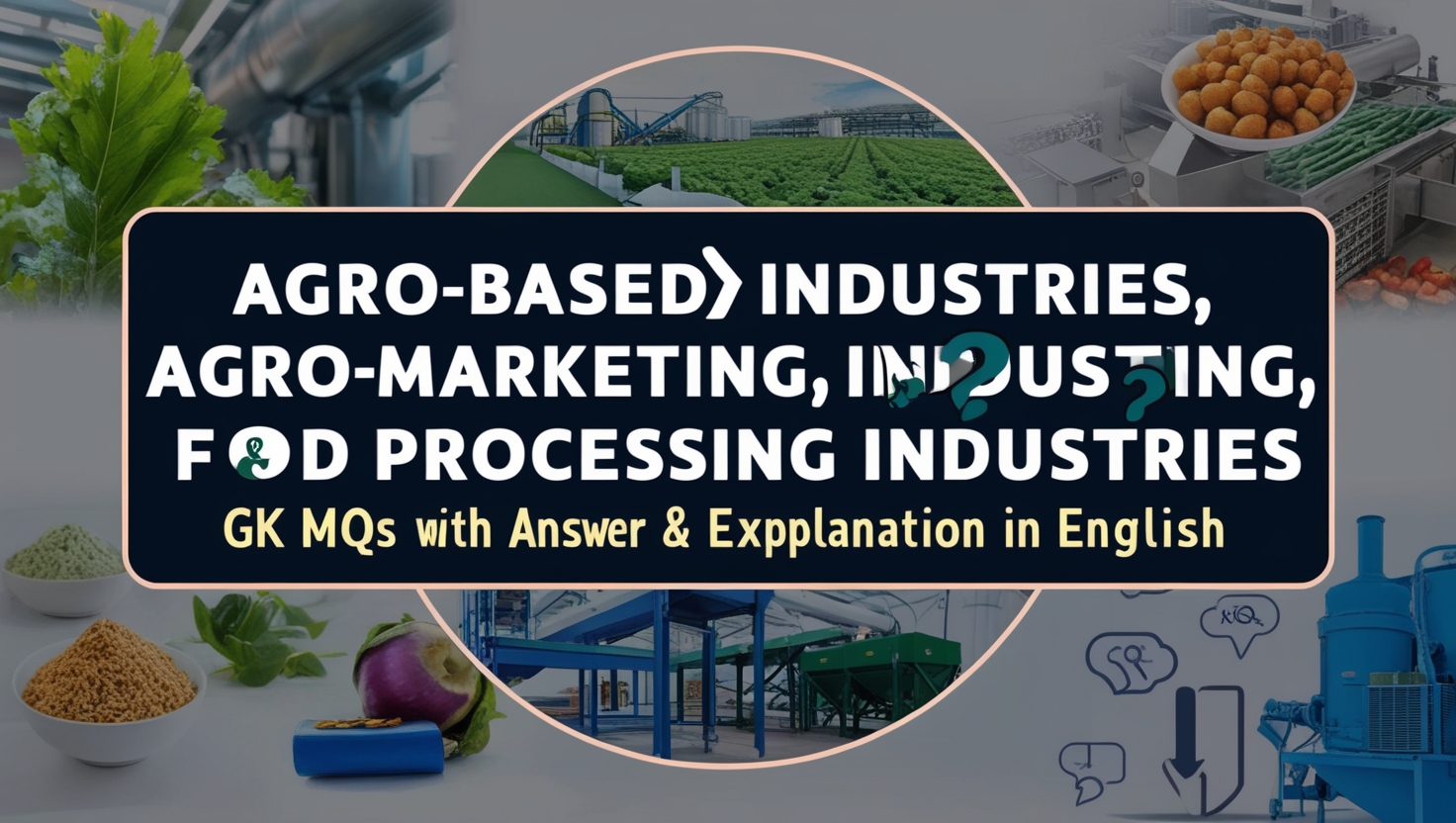
Agro-based industries, agro-marketing, and food processing play a pivotal role in transforming agricultural outputs into valuable products that support the economy. This article, titled Agro-based Industries, Agro-marketing, Food Processing Industries GK MCQs With Answer & Explanation in English, offers multiple-choice questions designed to test and deepen your knowledge of these essential sectors.
Each question is accompanied by detailed answers and explanations, making it a valuable resource for students, exam aspirants, and anyone interested in the agro-industry. Dive in to gain insights into how these industries add value and contribute to agricultural development.
1. First state in India to launch a policy to establish Special Agriculture Zones (SAZs):
- Uttar Pradesh
- Gujarat
- Haryana
- Uttarakhand
Show Answer
Answer: Uttarakhand
Uttarakhand initiated the establishment of Special Agricultural Zones (SAZs) in 2011. These zones were modeled after Special Economic Zones (SEZs) and aimed to encourage farmers in hilly regions to cultivate high-quality crop seeds suitable for their specific geographic conditions. The SAZs were designed to boost agricultural productivity and improve the livelihoods of farmers in Uttarakhand.
2. In the abbreviation APEDA, what does P stand for?
- Pisciculture
- Products
- Processed Food Products
- Promotion
Show Answer
Answer: Processed Food Products
APEDA, or the Agricultural and Processed Food Products Export Development Authority, is a significant institution under the Ministry of Commerce and Industry, Government of India. Its primary role is to promote and facilitate the export of agricultural and processed food products from India to the global market. APEDA plays a crucial role in enhancing India’s agricultural export capabilities and promoting its agricultural products worldwide.
3. International Rubber Study Group is located at?
- Kuala Lumpur
- Singapore
- Phnom Penh
- London
Show Answer
Answer: Singapore
The International Rubber Study Group is headquartered in Singapore. This international organization, established in 1944 in London and later moved to Singapore in 2008, serves as a platform for collaboration and information exchange in the global rubber industry. It provides valuable insights and research on the rubber market, supply, and demand dynamics, affecting the industry’s stakeholders.
4. Which of the following bodies procures, distributes, exports, and imports agricultural commodities?
- FCI
- NAFED
- NABARD
- All of them
Show Answer
Answer: NAFED
NAFED, or the National Agricultural Cooperative Marketing Federation of India Ltd., is a prominent cooperative body in India. NAFED’s mission involves procuring, distributing, exporting, and importing specific agricultural commodities to benefit Indian farmers. This cooperative organization plays a vital role in stabilizing crop prices, ensuring fair returns to farmers, and securing the country’s food security.
5. Bringing Green Revolution to Eastern India (BGREI) scheme mainly targets the improvement in production of which of the following in Eastern States?
- Rice
- Wheat
- Horticulture
- Both Rice and Wheat
Show Answer
Answer: Rice
The “Bringing Green Revolution to Eastern India” (BGREI) scheme primarily focuses on enhancing rice-based cropping systems in the eastern states of India. These states include Assam, West Bengal, Odisha, Bihar, Jharkhand, eastern Uttar Pradesh, and Chhattisgarh. The scheme aims to replicate the success of the Green Revolution in the eastern region by promoting improved agricultural practices, increasing crop yields, and enhancing food security.
6. Which of the following countries is the main competitor for the Indian jute industry?
- Japan
- China
- Sri Lanka
- Bangladesh
Show Answer
Answer: Bangladesh
Bangladesh is a significant competitor in the jute industry, particularly for India. It’s known for producing high-quality natural jute fibers, giving it an advantage in manufacturing top-grade jute products. The competition arises from the fact that both countries have a strong historical association with jute cultivation and processing.
7. Which country introduced Tobacco in India?
- Portuguese
- French
- British
- Dutch
Show Answer
Answer: Portuguese
Tobacco was introduced to India by the Portuguese during the 17th century. Since then, it has become an integral part of the country’s agriculture and industry.
8. What is India’s rank in the production of Tobacco in the world?
- 1
- 2
- 3
- 4
Show Answer
Answer: 2
India is the second-largest tobacco producer and exporter in the world. China is the largest producer and consumer of Tobacco.
9. What is the world’s largest tobacco exporter?
- Germany
- Brazil
- India
- Hungary
Show Answer
Answer: Brazil
Brazil is recognized as the world’s largest exporter of tobacco (both processed and unprocessed). India ranks as the second-largest tobacco exporter globally. The export of tobacco from India contributes significantly to its foreign trade.
10. In which year was the Tobacco Board established?
- 1980
- 1987
- 1976
- 1990
Show Answer
Answer: 1976
The Tobacco Board, established under the Tobacco Board Act, 1975, is a statutory body formed on January 1, 1976. It’s headquartered in Guntur, Andhra Pradesh, and is responsible for regulating and developing the tobacco industry in India. The board plays a pivotal role in ensuring the sustainability and competitiveness of the tobacco sector.







